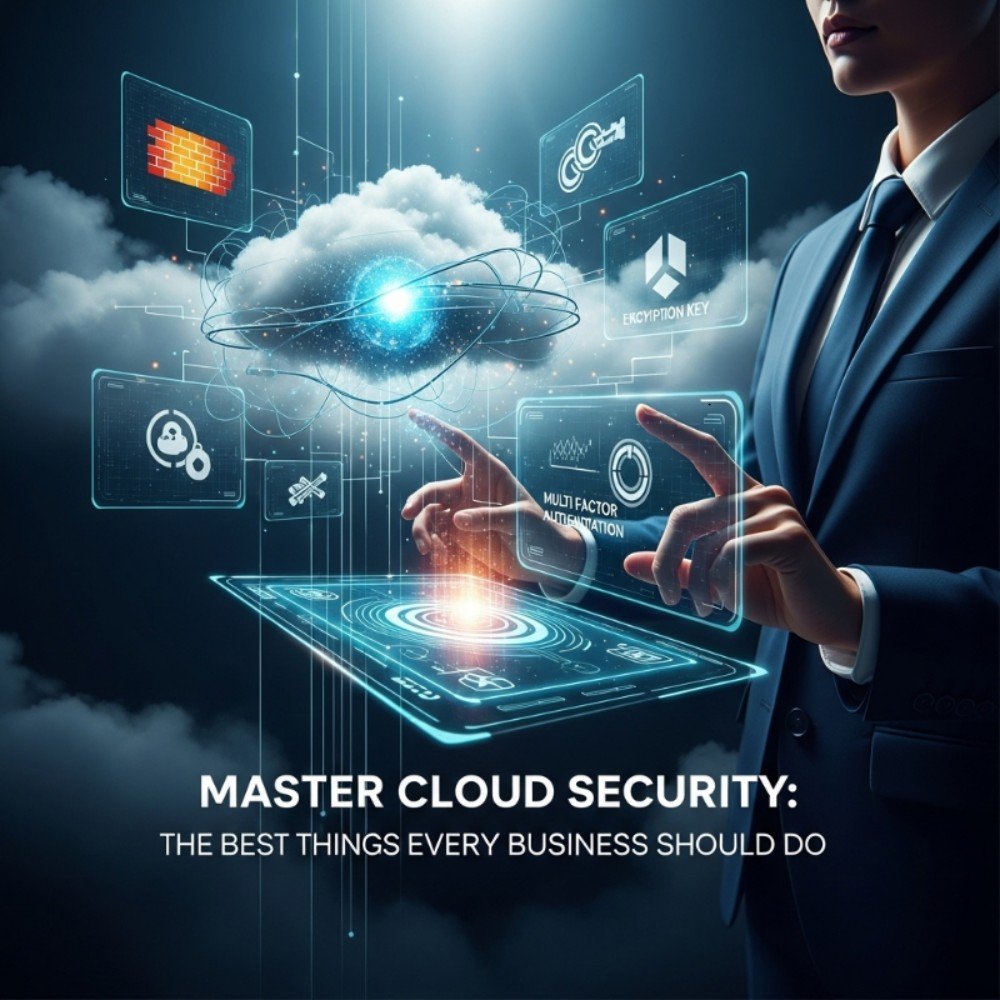Why Cloud Security Is More Important Than Ever
Master Cloud security computing is now the backbone of modern business operations because of how connected everything is in the digital world. The cloud offers unmatched flexibility, scalability, and efficiency for everything from startups managing remote teams to global companies running mission-critical applications. But there is one thing that is true about this rapid change: the more we rely on cloud infrastructure, the more open we are to advanced cyber threats.
The old model of perimeter-based security doesn’t work anymore as companies move their data, workflows, and systems to the cloud. Cybercriminals take advantage of weak authentication, misconfigured systems, and data-sharing holes to turn what used to be a productivity powerhouse into a possible security minefield. So, cloud security isn’t a luxury or an afterthought; it’s something that has to be done. Companies that don’t make it a priority risk losing money and damaging their trust and reputation beyond repair.

The Growth of Cloud Computing in Today’s Business
Cloud computing has changed the way businesses store, process, and access data in the last ten years. What used to take a lot of servers and expensive maintenance can now be done with just a few clicks. Businesses are using public, private, and hybrid clouds to make their operations more efficient, grow faster, and save money on infrastructure.
The global shift to remote work sped up this digital transformation even more. Collaboration platforms, data analytics, and customer relationship systems are all now in the cloud, which lets teams work together smoothly from anywhere in the world. Cloud computing has made the playing field more even by giving small businesses access to technology that big businesses use and letting big businesses come up with new ideas without limits.
here is some other aricticle https://www.ibm.com/think/topics/cloud-security
But this ease of use also makes things more complicated. As more systems and private data go online, security holes grow, making cloud protection a business need instead of a nice-to-have feature.
Finding out about the risks that aren’t obvious in the cloud age
The cloud has a lot of potential, but it also brings up security problems that traditional IT systems never had to deal with. If storage buckets aren’t set up correctly, they can make millions of records available to the public. If you don’t manage your identity well, people who shouldn’t be able to access sensitive systems can get in. Even third-party vendors that you trust can accidentally let hackers in.
People often don’t understand shared responsibility models, which say that both cloud providers and customers are responsible for security. A lot of businesses think that the provider takes care of all security, but they find out too late that they still have to encrypt data, control access, and follow the rules.
When you add in the rising threat of ransomware, phishing, and AI-driven cyberattacks, it’s clear that the cloud is both a powerful tool and a possible target. Companies need to understand that moving to the cloud is just the beginning; they need to stay alert, defend themselves proactively, and learn about new digital threats as they happen.
Finding the main dangers to cloud environments
As more and more businesses move their data and operations to the cloud, the security landscape becomes more complicated and, at times, dangerous. The cloud is easy to use, flexible, and scalable, but it also has a dark side: a new set of weaknesses that hackers are eager to take advantage of. Cloud environments are full of dangers that need constant attention, from data breaches to misconfigurations to human error. The first step to protecting digital assets and keeping trust in a world where one small mistake can cost a lot of money is to understand these main threats.
Unauthorised Access and Data Breaches
“Data breach” is a phrase that makes any organisation shiver. In a world driven by the cloud, these breaches have become more advanced, often using stolen credentials, weak authentication systems, or unencrypted data transmissions to get into important systems.
By design, cloud environments can be accessed from almost anywhere. This is a strength and a weakness at the same time. If access controls aren’t perfect, hackers can get in without being noticed by taking advantage of permissions that were missed or accounts that were hacked. Once inside, they can steal sensitive information like customer data, financial records, and intellectual property, and they can even stop operations.
Also, the rise of AI-driven hacking tools has made it easier and faster to break into systems. Attackers don’t have to be tech geniuses anymore; automated scripts and smart malware can now get around regular defences with scary accuracy. Multi-factor authentication (MFA), strong encryption, and constant access monitoring are the answers. Companies need to see identity as the new perimeter and protect it with the same care they used to protect physical firewalls.
Misconfigurations: The Silent Killer of Security
Misconfigurations are the cloud’s secret enemy; you can’t see them until it’s too late. Small mistakes in setup, like leaving an open storage bucket, setting up the network wrong, or giving too many people access, can make big holes in security.
Studies show that a large number of cloud breaches are not caused by hackers from the outside but by people making mistakes. If you don’t tick a box or change a default setting, terabytes of private information can be made public on the internet. Cybercriminals often look for these weak spots on the web, targeting things like unprotected databases and APIs that aren’t set up correctly.
The problem is that these mistakes happen very easily. Managing configurations across different platforms is getting harder as more companies use multi-cloud strategies. Even experienced IT teams can leave holes if there aren’t consistent rules and automated security checks.
What is the cure? Automation and being able to see things. Tools that constantly check cloud configurations, make sure they meet compliance standards, and alert you to problems as they happen can help keep the silent killer from getting you. In the cloud, prevention isn’t just better than cure; it’s often the only way to get better.
Mistakes by people and insider threats
People pay a lot of attention to hackers from outside the company, but the most unpredictable threat often comes from within. Insider threats, whether they are intentional or not, are still one of the hardest security problems to find and fix.
An unhappy worker might leak private information or mess up systems on purpose. But most of the time, breaches happen because people make careless mistakes, like sharing passwords over insecure channels, falling for phishing emails, or mismanaging privileged access. The human factor makes even the safest systems chaotic.
Cloud environments make this risk worse because they are spread out. Employees, contractors, and partners can use a wide range of devices and networks to get to systems from anywhere. Without strict access controls, monitoring of user behaviour, and ongoing cybersecurity training, the chances of mistakes happening inside the company go up a lot.
Zero Trust frameworks, least-privilege policies, and real-time behavioural analytics are the best ways to protect yourself. These strategies make sure that trust is never taken for granted, access is always checked, and strange things are found quickly. Technology can make walls, but awareness and responsibility keep them up.
The biggest danger to cloud environments isn’t just technology; it’s being too comfortable. Cloud cybersecurity is a process that is always changing, not a set of rules. Businesses can turn their cloud from a risk zone into a fortress of innovation and resilience by finding these main threats early and dealing with them before they become problems.
Making a Strong Framework for Cloud Security
The cloud is no longer a luxury in today’s highly connected digital world; it’s the backbone of how businesses run today. But as companies move their work online, it gets harder to keep private information safe. It’s not enough to just put up defences to make cloud security strong. You also need to create a culture of security where trust, openness, and resilience are at the heart of every system, user, and process.
To do this, smart companies are using a layered approach that includes Zero Trust principles, multi-factor authentication, and strong encryption standards. These things work together to make up the foundation of a cloud infrastructure that can not only withstand attacks but also change as the threat landscape changes.
Using Zero Trust Architecture
In the past, once someone got into a network, they were automatically trusted. That method doesn’t work anymore in the cloud age, when users, devices, and data are always moving between on-premise and remote environments. The Zero Trust Architecture (ZTA) says, “Never trust, always verify,” which is the opposite of what this says.
Zero Trust says that every connection, whether it’s internal or external, could be hacked. It doesn’t just give everyone access; it checks everyone at every step. Before getting or keeping access to resources, each user, device, and application must constantly authenticate.
There are a few important steps to take when using Zero Trust in the cloud:
Micro-segmentation means breaking up networks into smaller areas to keep possible breaches from spreading.
Identity-based access controls: Making sure that only verified users can get to certain data or systems.
Continuous monitoring: Using AI and data analysis to find problems as they happen.
This method makes the attack surface smaller and limits lateral movement. This means that even if an attacker gets past one layer, they can’t move around your network freely. In short, Zero Trust makes your cloud a digital fortress where no one ever sleeps.
Multi-Factor Authentication (MFA) as the First Line of Defence

data network businessman bitcoins cloud padlock security vector illustration
Just having a password isn’t enough anymore. Multi-Factor Authentication (MFA) is an important way to protect cloud systems from phishing attacks, credential stuffing, and password leaks, which are becoming more and more common.
MFA needs users to give two or more proof factors, like a password, a phone or token, or a biometric signature. This layered method makes it very unlikely that someone will be able to get in without permission, even if login information is stolen.
Companies that work in the cloud should have a policy that says all accounts, even administrative ones, must have MFA turned on. Adding adaptive MFA, which changes authentication requirements based on things like device type or location, can make security even better without slowing down work.
MFA is the first and most reliable line of defence between your data and people who want to steal it in a world where cybercriminals can automate attacks at an alarming rate.
Secure Data Management and Encryption
Data can still be exposed even with the best defences. This is why encryption is still the most important part of cloud security. Even if hackers get their hands on data, they won’t be able to read or use it without the right decryption keys.
Every step in the cloud should use encryption:
In transit (data moving between servers, users, and apps)
At rest (data that is stored in cloud databases or backups)
When cloud apps are using data, this is called processing.
AES-256 and other advanced encryption algorithms, along with good key management practices, make it almost impossible for someone to get in without permission. Companies should also keep a close eye on who has encryption keys. The best way to do this is to use hardware security modules (HSMs) or managed key services to reduce the risk of human error.
Data classification and lifecycle management are just as important as encryption. Companies can follow rules like GDPR or ISO 27001 by putting the right level of protection on information based on how sensitive it is.
It takes careful planning, ongoing adaptation, and proactive defence to build a strong cloud security framework. Organisations can turn their cloud infrastructure from a weak point into a model of digital resilience by using Zero Trust principles, requiring MFA, and putting encryption first.
One thing that will never change is that a secure cloud is a strong base for innovation, trust, and growth.
The best ways to manage cloud security
As more and more companies use the cloud to store data, run applications, and run their businesses, keeping cloud security in check has become a top priority. The cloud is faster, more flexible, and easier to work with than ever before. However, these benefits also make you more vulnerable to cyber threats. A single mistake in software management, access control, or configuration can lead to terrible breaches.
Organisations need to take a strategic, proactive approach to cloud security management in order to protect digital assets and stay compliant. This means using automation, visibility, and human oversight together to find weaknesses before attackers do. Regular audits, access control management, and software updates are the most important things you can do to keep your cloud environment safe and stable.
Regular checks and constant watching
Setting up cloud security isn’t something you do once; it’s something you do all the time. Every day, threats change and new weaknesses appear as systems grow. That’s why it’s important to do regular security audits and keep an eye on things all the time.
When you do a cloud security audit, you check the settings, permissions, and data storage policies to make sure they follow both internal and external rules. These audits help find security holes that could be caused by misconfigured settings, old policies, or accounts that aren’t being used.
But audits by themselves aren’t enough. Continuous monitoring adds a layer of protection that works in real time. It uses AI and analytics to track strange activities across your infrastructure. This includes finding patterns of data exfiltration, unauthorised access attempts, and suspicious logins.
When used together, audits and monitoring give you two benefits: they help you avoid problems and find them right away. The goal isn’t just to find weaknesses; it’s also to spot threats before they can do any damage and stop them. Companies that regularly audit and monitor their systems don’t just fix security problems; they get better at dealing with them.
Managing policies for access control and least privilege
Controlling who has access to what is very important in cloud environments because resources are spread out and users can connect from anywhere. One of the most common reasons for data breaches is giving people the wrong access rights. One of the most important ways to protect against insider threats and outside exploitation is to use least privilege policies, which give users only the access they need to do their jobs.
Role-based access control (RBAC) is the first step to good access management. It makes sure that permissions match job duties. Regularly reviewing and taking away unnecessary privileges makes sure that former employees, unused accounts, or outside vendors can’t get into sensitive systems.
Also, using Identity and Access Management (IAM) tools can help enforce policies automatically and make sure that all cloud services are following the rules. These systems can keep track of every request for access, verify identities, and enforce security policies in real time.
Organisations that use a least privilege approach not only lower their risk, but they also make it harder for attacks to spread. Even if one account is hacked, the damage stays limited, keeping the system as a whole safe.
Updating Software and APIs
Software and APIs in the cloud connect apps, services, and users. However, if these parts are not taken care of, they can become weak links. Cybercriminals are quick to take advantage of unpatched vulnerabilities in old software.
To fight this, companies need to set up a strict system for managing patches and updates on a regular basis. This includes:
Automating updates when possible to cut down on mistakes made by people.
To avoid problems, test patches in controlled settings before putting them into use.
Keeping an eye on vendor alerts for known weaknesses and fixing them right away.
APIs, in particular, need to be watched all the time. If APIs aren’t well protected, attackers can get to data, authentication tokens, or backend services. Using API gateways, strong authentication, and rate limiting can stop people from getting in and abusing the system.
Organisations can greatly lower their risk of known exploits by keeping all of their layers, from the operating system to the application interface, up to date. In the cloud, where time is money, quick patching is the best way to stay safe.
A complete, ever-changing framework that includes vigilance, discipline, and smart technology is what makes cloud security management work. Regular audits improve oversight, access control keeps people out, and timely updates make defences stronger.
In the cloud age, security isn’t about getting rid of risk; it’s about staying one step ahead of it. Not only do businesses that know how to do these things protect their data, but they also build trust, resilience, and confidence in a digital world that is always changing.
Conclusion: How to Build a Strong Cloud Security Posture
Resilience is the real measure of cloud security success in a time when the cloud is the heart of digital transformation. No one tool, policy, or strategy can guarantee complete safety, but the right technology, strong governance, and empowered people can work together to make a defence system that adapts, learns, and lasts. It’s not about being perfect when it comes to building a strong cloud security posture; it’s about being ready, flexible, and trusting when problems come up.
In the modern cloud era, businesses that do well are those that know one important thing: security is not a product; it’s a way of thinking. It is a constant, changing promise to protect data, respect privacy, and allow innovation without fear.
Bringing together technology, policy, and people
A strong cloud security posture comes from harmony, which is when technology, policy, and human intelligence all work together without problems.
Technology is the backbone that gives us the tools for real-time monitoring, encryption, and automation that can find and respond to threats faster than any manual process. Smart technologies make the shield that protects important assets, from Zero Trust architectures to AI-powered analytics.
Policy gives things a structure. Clear rules for governance, compliance, and risk management make sure that security is not only reactive but also deeply ingrained in all parts of a business. Policies need to change as technology does, and they should help people make decisions about data access, third-party integrations, and compliance with rules.
And last but not least, people are what make security work. Even the best systems won’t work if the people who use them aren’t aware of them, trained, and ready to act. Everyone in the company, from the IT team to the executives, is responsible for keeping the company safe. Businesses turn their teams from potential weaknesses into active defenders of digital integrity by teaching them and creating a culture of responsibility.
To sum up, technology stops threats, policies stop mistakes, and people make sure that both work with purpose and accuracy. They make up the three parts of resilience that make up strong cloud security.
The Ongoing Path to Cloud Security Mastery
Cloud security isn’t a place you get to; it’s a journey that never ends. Every day, the digital world changes, and so do the threats that are out there. Hackers come up with new ways to break into systems, technologies change, and rules get stricter. Organisations need to treat cloud security like a living system that learns, changes, and gets stronger with each problem in order to stay ahead.
1. This means accepting that things will always get better:
2. Regularly checking for weaknesses and making defences stronger.
3. Checking systems for compliance and gaps in performance.
4. Using new technologies that make things easier to see and control.
It also means encouraging a way of thinking that is open to others and interested in learning. Cloud providers, developers, and users all need to share information, learn from mistakes, and work together to improve security standards. Every lesson learnt, every vulnerability fixed, and every breach stopped is a step forward in learning how to make the cloud more resilient.
In the end, the future will be shaped by those who find a balance between being creative and being careful. Companies that make security a core part of their culture, not just a box to tick or a last step, will be the ones that earn trust, handle problems, and lead the digital age with confidence.
It takes time, effort, and planning to build a strong cloud security posture. Organisations can turn the cloud from a possible risk into their most secure and empowering asset by combining the power of technology, the clarity of policy, and the wisdom of people.
In the end, learning how to keep your data safe in the cloud isn’t just about keeping your data safe; it’s also about keeping your business’s future safe.

